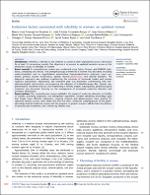| dc.contributor.author | Concepción Zavaleta, Marcio José | |
| dc.contributor.author | Coronado-Arroyo, Julia Cristina | |
| dc.contributor.author | Quiroz-Aldave, Juan | |
| dc.contributor.author | Durand-Vásquez, María del Carmen | |
| dc.contributor.author | Ildefonso-Najarro, Sofía | |
| dc.contributor.author | Rafael-Robles, Luciana | |
| dc.contributor.author | Concepción- Urteaga, Luis | |
| dc.contributor.author | Gamarra Osorio, Elman Rolando | |
| dc.contributor.author | Suárez Rojas, Jacsel | |
| dc.contributor.author | Paz-Ibarra, José | |
| dc.date.accessioned | 2023-12-14T14:57:18Z | |
| dc.date.available | 2023-12-14T14:57:18Z | |
| dc.date.issued | 2023-09-04 | |
| dc.identifier.citation | Expert Review of Endocrinology & Metabolism. 2023; 18(5). | es_PE |
| dc.identifier.uri | https://hdl.handle.net/20.500.12959/4705 | |
| dc.description.abstract | Introduction: Infertility is defined as the inability to conceive after unprotected sexual intercourse for at least 12 consecutive months. Our objective is to present an updated narrative review on the endocrine causes of infertility in women. Areas covered: A comprehensive review was conducted using Scielo, Scopus, and EMBASE databases, comprising 245 articles. The pathophysiology of infertility in women was described, including endocrinopathies such as hypothalamic amenorrhea, hyperprolactinemia, polycystic ovary syndrome, primary ovarian insufficiency, obesity, thyroid dysfunction, and adrenal disorders. The diagnostic approach was outlined, emphasizing the necessity of hormonal studies and ovarian response assessments. Additionally, the treatment plan was presented, commencing with non-pharmacological interventions, encompassing the adoption of a Mediterranean diet, vitamin supplementation, moderate exercise, and maintaining a healthy weight. Subsequently, pharmacological treatment was discussed, focusing on the management of associated endocrine disorders and ovulatory dysfunction. Expert opinion: This comprehensive review highlights the impact of endocrine disorders on fertility in women, providing diagnostic and therapeutic algorithms. Despite remaining knowledge gaps that hinder more effective treatments, ongoing research and advancements show promise for improved fertility success rates within the next five years. Enhanced comprehension of the pathophysiology behind endocrine causes and the progress in genetic research will facilitate the delivery of personalized treatments, thus enhancing fertility rates. | es_PE |
| dc.format | application/pdf | es_PE |
| dc.language.iso | eng | es_PE |
| dc.publisher | Taylor & Francis Group | es_PE |
| dc.relation.uri | https://www.tandfonline.com/doi/full/10.1080/17446651.2023.2256405 | es_PE |
| dc.rights | info:eu-repo/semantics/openAccess | es_PE |
| dc.rights.uri | https://creativecommons.org/licenses/by-nc-sa/4.0/ | es_PE |
| dc.subject | Fertility | es_PE |
| dc.subject | Female infertility | es_PE |
| dc.subject | Anovulation | es_PE |
| dc.subject | Reproductive health | es_PE |
| dc.subject | Ovarian reserve | es_PE |
| dc.subject | Hormones | es_PE |
| dc.title | Endocrine factors associated with infertility in women: an updated review | es_PE |
| dc.type | info:eu-repo/semantics/article | es_PE |
| dc.subject.ocde | https://purl.org/pe-repo/ocde/ford#3.02.18 | es_PE |
| dc.identifier.doi | https://doi.org/10.1080/17446651.2023.2256405 | |






